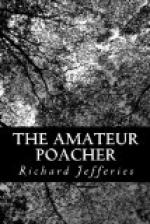A large white spot, ill-defined and shapeless in the distance and the dimness, glides along the edge of the wood, then across in front before the fir plantation, next down the hedge to the left, and presently passes within two yards, going towards the wood again along this mound. It is a white owl: he flies about five feet from the ground and absolutely without a sound. So when you are walking at night it is quite startling to have one come overhead, approaching from behind and suddenly appearing. This owl is almost fearless; unless purposely alarmed he will scarcely notice you, and not at all if you are still.
As he reaches the wood he leaves the hedge, having gone all round the field, and crosses to a small detached circular fir plantation in the centre. There he goes out of sight a minute or two; but presently appears skirting the low shed and rickyard yonder, and is finally lost behind the hedges. This round he will go every evening, and almost exactly at the same time—that is, in reference to the sun, which is the clock of nature.
Step never so quietly out from the mound, the small birds that unnoticed have come to roost in the bushes will hear it and fly off in alarm. The rabbits that are near the hedge rush in; those that are far from home crouch in the furrows and the bunches. Crossing the open field, they suddenly start as it seems from under your feet—one white tail goes dapping up and down this way, another jerks over the ‘lands’ that way. The moonbeams now glisten on the double-barrel; and a bright sparkle glitters here and there as a dewdrop catches a ray.
Upon the grass a faint halo appears; it is a narrow band of light encircling the path, an oval ring—perhaps rather horseshoe shape than oval. It glides in front, keeping ever at the same distance as you walk, as if there the eye was focussed. This is only seen when the grass is wet with dew, and better in short grass than long. Where it shines the grass looks a paler green. Passing gently along a hedge thickly timbered with oak and elms, a hawk may perhaps start forth: hawks sometimes linger by the hedges till late, but it is not often that you can shoot one at roost except in spring. Then they invariably return to roost in the nest tree, and are watched there, and so shot, a gunner approaching on each side of the hedge. In the lane dark objects—rabbits—hasten away, and presently the footpath crosses the still motionless brook near where it flows into the mere.
The low brick parapet of the bridge is overgrown with mosses; great hedges grow each side, and the willows, long uncut, almost meet in the centre. In one hedge an opening leads to a drinking-place for cattle: peering noiselessly over the parapet between the boughs, the coots and moorhens may be seen there feeding by the shore. They have come up from the mere as the ducks and teal do in the winter. The broader waters can scarcely be netted without a boat, but




